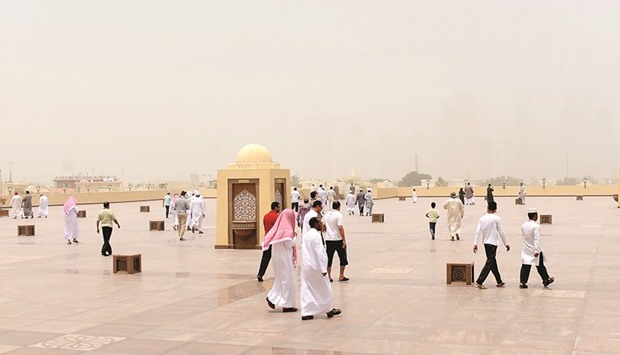It has been horribly dusty across Qatar recently. For several days it was almost impossible to make out the towers of West Bay and the dust got everywhere. It coated the furniture, found its way into cupboards and turned tiled floors into hazardous skating rinks. On the worst day of the dust, Friday, June 17, I’m sure I could even feel the dust hit the back of my throat.
Apparently it’s not just my imagination, numerous studies have shown that dust can be damaging to your health. Research has also revealed that communities in the Middle East have higher incidences of asthma than might be expected, and the number of asthma hospitalisations increases during severe dust storms.
Unfortunately, dust is one of the hazards of living in a desert. If we are to enjoy the mild winters, and the sparse rainfall, then we have to accept the loose particles as a way of life. Of course in Doha, there is also a lot of construction and a large number of vehicles and this all adds to the amount of debris in the air.
Needless to say, not all particles are the same. They can come in all shapes and sizes, and some are far more hazardous than others. In the scientific world, they are known as ‘PM’, which stands for ‘particulate matter’, and they’re usually classed according to their size. Those which are bigger than 10 microns in diameter are generally ignored as they can be filtered out in the nose or throat. 10 microns is just 0.001 mm, but this is clearly enormous when we’re talking about dust! Particles this size are generally considered to be a nuisance rather than a health risk.
There is growing evidence, however, that those particles which are smaller than 10 microns are damaging to our health. These smaller particles are sorted into two categories. The larger ones are between 2.5 and 10 microns in diameter and are called PM10, whereas the smaller ones are less than 2.5 microns in diameter are called PM2.5. Both are clearly very small and the smaller ones, the PM2.5 particles, are 100 times smaller than the width of a human hair.
To give you some kind of idea as to how small these particles are, a tiny grain of sand is usually over 60 microns in diameter, far too big even to be classed as the larger PM10 particle. This explains why sand is considered to be such a heavy particle. Even a strong wind will have difficulty lifting sand over about knee height. Other particles from a desert which aren’t sand, however, such as silt and clay, can be any size, and these pose more of a threat to our health.
Aside from desert debris, the different sized particles are usually created from different things. PM10 particles are made up of smoke and dirt from factories and farming, as well as from tiny pieces of rocks and plant spores. They are generally created by grinding rocks or turning soil, and the particles are then blown by wind.
PM2.5 particles, on the other hand, are often comprised of toxic organic compounds and heavy metals. These finer particles are generated by the exhaust of vehicles, the burning of plants or by metal processing plants. The PM2.5 particles clearly sound more toxic than the larger particles, but this isn’t the only reason that they are more dangerous.
You might think that the smaller particles would do less damage to your health than the larger ones, but it’s actually the finer particles that are more dangerous. The larger ones are more likely to get stuck to the sides of your lungs, but the smaller particles can travel deeper into them. If the toxins become embedded, they can cause various lung diseases and even lung cancer.
Unfortunately as well as being more hazardous, these finer particles can also spend longer suspended in the atmosphere. The larger ones will tend to settle out of the air after just a few hours, but the PM2.5 particles can travel for hundreds of kilometres and can stay in the air for days or even weeks.
Fine dust from the Sahara desert is regularly blown across the Atlantic as far as Central and South America. It can take over a week for the journey, which is undertaken by millions of tonnes of dust which is transported to the Amazon rainforest every year. This sounds like a curse for the environment, but in fact these particles include nutrient-rich sediment essential to the ecosystem.
In 2014, the World Health Organisation released a database of air pollution recorded in cities across the world. 1,600 cities were listed, spread across 91 countries. According to this list, Doha had the 12th highest average levels of PM2.5 particles, even beating Beijing, which is often making headlines for its poor air quality.
The small particles generated in Doha are generally made from construction dust and vehicle exhaust. However, some of our fine dust is also swept in from the north. A strong wind will often pick up small particles from the dried up river beds of the Euphrates and Tigress rivers and sweep them down the Gulf towards Qatar.
In order to eliminate the dust from the atmosphere, Doha could enforce more restrictions on construction and vehicles. However, it would also have to reduce the number of particles which are blown into Doha from elsewhere. Given that we are surrounded by countries with desert environments, this would be virtually impossible. There is no escaping the fact that deserts are dry places, and in dry places there is dust.

VANISHING SKYLINE: Friday, June 17, was the worst day of dust in Doha in recent days.


